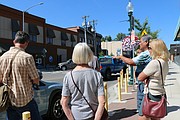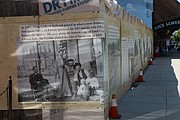Trails, trials and a little town called Sandpoint
SANDPOINT — Now the heart of Sandpoint, the Panida wasn't the community's first theater. It wasn't even the second.
It was likely the fourth active theater in the city when the Spanish mission-style structure was built for $70,000 in 1927 by F.C. Weskil.
"Of course, this is pre-radio, pre-television," tour guide Chris Corpus, a regular volunteer for the Bonner County History Museum, told the half-dozen participants of a recent tour.
The theater also serves as the starting point for the city of Sandpoint's "A Walk through History", a series of self-guided historic tours of the city offered by the city's Historic Preservation Commission and the Bonner County History Museum.
On the last Friday of the month — as well as the occasional Saturday — a free tour is led by members of Lake Pend Oreille Repertory Theatre and the Bonner County History Museum. The tour, which is conducted from June to September, begins at 10 a.m. in front of the Panida, 300 N. First Ave.
A digital version of the tour is also available for those wishing to go on the tour on their own.
There are three tour options — downtown, which focuses on downtown core businesses and retail areas, including the Sandpoint Historic District; additional city sites, which include Lakeview Park, Kinnikinnick Native Plant Garden and Arboretum; and a south Sandpoint tour, which includes a large number of historic homes.
As the group walked along First Avenue, Corpus and Bigley encouraged tour participants to peek down the alley toward Sand Creek. Just past the railroad tracks on the other side of the creek is where the town originally began.
"It gradually expanded over here, and over time, this became the town and left that area behind," Bigley told the group.
The railroad and timber industries are central to Sandpoint's origin story, and, in the 1940s, the presence of the nearby Farragut Naval Training Station at the southern end of Lake Pend Oreille saw many sailors and officers headed to the city for something to do.
"They wanted to have a naval training area somewhere hidden so they wouldn't get bombed," Corpus added. "The story is that Eleanor Roosevelt was going to a talk in Seattle, and the plane flew over, and there was this beautiful lake with these big mountains … So she talked to her husband and said, 'Hey, this might be a good place to build an inland Marine or Navy training center.'"
More than 40,000 sailors were trained at the facility, with some of it now a state park and another portion converted into a submarine testing site still in use today, he told the group.
"All of those sailors, just a few miles away, brought a lot of money to the town," Bigley said.
Then, as the group turned west to walk up Main Street, the pair encouraged tour participants to look toward Schweitzer, now one of the region's premier ski destinations.
"They went around town and told everyone they were going to buy a share in Schweitzer," Corpus said. "People went, 'Uh, sure' and paid the $25, which was a lot of money back then."
As the group walked along Main Street, past the original Sandpoint City Hall, the pair told tour participants of the area's many working dairy farms and how there were several creameries in town. They talked of the railroad and how the race to build a transcontinental railway heralded a new era in the region.
"[The railroads] were in a race to build the railway and to get the land grants that came along with the funding," Corpus said. "They'd get 10 square miles, typically, all along their route."
In 1881, the Northern Pacific arrived in Sandpoint — after overcoming the significant challenge of building a bridge across Lake Pend Oreille, the pair said.
Corpus and Bigley talked of how railroad towns were almost "traveling tent cities." As the crews arrived in an area, they would toss down their stuff and then get to work. Gradually, the tents became wooden structures — a natural progression due to the region's forests. After numerous fires devastated the wooden structures, they were gradually replaced with brick — almost all of it made locally.
The pair talked of early settlers and town founders L.D. and Ella Mae Farmin — they didn't believe in naming things after themselves, which is one of the reasons why there is a park named after the couple and not the town. They talked of explorer David Thompson, one of the region's earliest white explorers.
They noted that the area that now forms the town of Sandpoint fell outside the railroad land, which left it open for bid.
"One hundred and sixty acres, which even back then was being proven to be not enough acreage to sustain anybody in the West because of water," Corpus said.
Of the city's move from the east side of Sand Creek to the west side. Prone to flooding and constant fires, the town gradually migrated to its current location.
"One story is that a fire came and almost took out the whole original Sandpoint, the railroad's Sandpoint," he told the group. "Because they couldn't stop it, they had to dynamite one of the buildings just to give them a chance to fight the fire and save part of it."
Making their way down Second Avenue, Corpus and Bigley told of how the forests inspired the names for many of the streets to be named after trees. They pointed out where the horse-drawn fire wagons pulled out of the old city hall, now home to the Music Conservatory of Sandpoint.
Pointing out how Main Street angles instead of going straight, they noted how it was once the location of a trolley, which took workers from the homes that once stood where the downtown and city core now lay, not to the lumber mills outside of town.
They talked of the many service organizations, pointing out several buildings where they were housed.
"Ella Mae Farmin once [said] that every time somebody started a new service organization, she was asked to be a part of it to legitimize the whole thing," Corpus said.
Pointing to several precast cement block buildings, Bigley told of how workers had to drive pilings a significant distance because of the amount of clay and sand.
"Sand and clay are one of the most common geologic features of this area because of the glacier period," added Corpus. "So they had to spend all their time dragging these piles into the ground — somewhere along the lines of depths of 200 feet to 300 feet."
As the group walked past Second Avenue, they pointed out the original Sandpoint Federal Building, which was named to the National Register of Historic Places in 1973. When the new library was built at Division and Cedar on the other side of town in 2000, the pair told of how Sandpoint residents transferred hundreds of books via a one-mile book brigade.
It was just one of the hundreds of nuggets, stories, and tales told of Sandpoint's beginnings — and leaning into how it became the community it is today.
Stopping in front of the Cedar Street Bridge, Bigley told of the infamous tale of two bridges.
As the story goes, the Farmins and fellow settler Ignatz Wiel were each building a bridge to connect the east side of Sand Creek to the growing area to the west; each racing to finish first. While Farmin traveled to the county seat — a several-day journey — to get an injunction to force Wiel to halt construction, the man got as many workers together as he could and finished the bridge before Farmin got back.
The tour highlights information on over 25 sites nestled within Sandpoint’s Historic National Registry District, said Heather Upon, the city of Sandpoint’s arts and historic preservation officer.
The city loves the partnership with the museum and the ability to have local historians and performance artists lead the tour.
"This walking tour is an excellent example of the exciting new programming that you will see from the newly merged Arts, Culture, and Historic Preservation Commission," Upton said. "We are so lucky to have such talent in our community, bringing to life Sandpoint’s rich history in a creative way."
The tours are roughly one hour; and while not required, pre-registration is encouraged. Tours are planned for Aug. 25, Sept. 2, and Sept. 29.
Information: sandpointidaho.gov






